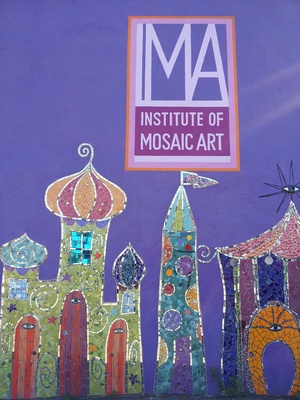 former Institute of Mosaic Art
former Institute of Mosaic Art
Jingletown, also known as the North Kennedy Tract, is a small arts community in Fruitvale, East Oakland, located adjacent to the Oakland Estuary and bordered by the Nimitz Freeway (I-880) and the Coast Guard Island and Fruitvale bridges. It is home to the Institute of Mosaic Art, Green Day's Jingletown Recording, and Ale Industries. Previous to this, it was the site of a Costanoan shellmound, and later grew up into a majority Portuguese and Azorean working-class neighborhood. According to local lore, the North Kennedy Tract was named "Jingletown" after the male Portuguese and Azorean immigrants who, previously impoverished, would walk the streets proudly jingling the coins they were able to earn and save due to the area's industrial boom. They apparently kept their coins on their person because of their distrust toward banks.
History
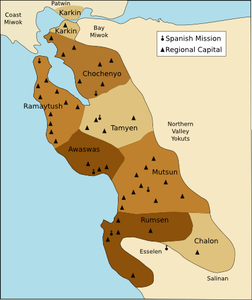 Ohlone languages and settlements mapBefore European contact, the shore of the Oakland Estuary was the site of a Costanoan (Ohlone) shellmound. During Spanish rule, the surrounding area was issued to Spanish soldier Luis María Peralta as part of a large land grant by the last Spanish governor of California, Pablo Vicente de Solá, on August 3, 1820. The land was named Rancho San Antonio (California Historical Landmark #246), and included the lands that are now the cities of San Leandro, Oakland, Alameda, Emeryville, Albany and Piedmont. The following year, Mexico gained its independence from Spain, and California became Mexican territory. The Mexican-American War (la Intervención estadounidense en México) began in 1846, and by September 9, 1850, California was admitted into the union of the United States of America.
Ohlone languages and settlements mapBefore European contact, the shore of the Oakland Estuary was the site of a Costanoan (Ohlone) shellmound. During Spanish rule, the surrounding area was issued to Spanish soldier Luis María Peralta as part of a large land grant by the last Spanish governor of California, Pablo Vicente de Solá, on August 3, 1820. The land was named Rancho San Antonio (California Historical Landmark #246), and included the lands that are now the cities of San Leandro, Oakland, Alameda, Emeryville, Albany and Piedmont. The following year, Mexico gained its independence from Spain, and California became Mexican territory. The Mexican-American War (la Intervención estadounidense en México) began in 1846, and by September 9, 1850, California was admitted into the union of the United States of America.
In 1851, J.B. Larue purchased Peralta's land east of San Antonio Creek (also known as the Oakland Estuary), in what is now part of East Oakland. He built there a wharf and a store, and thus the beginnings of the industrial infrastructure that would rapidly change the area's demographics during the late 1800s. Around that time, Captain E. F. Rodgers bought land in the area and created a nursery and farm he called "Shell Mound" after the shellmound at the estuary. In 1861, his land was taken over by a Civil War officer by the name of Kennedy and was used as an encampment of 500 or so troops. In 1876-77, and again in 1888, tract maps were filed for this area under the name of "North Kennedy".
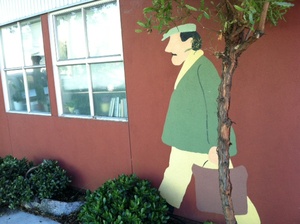 A Mural on the side of the Jingletown Arts and Business Community building
A Mural on the side of the Jingletown Arts and Business Community building
Portuguese and Azoreans (Atlantic island Portuguese) became a dominant co-ethnic group in East Oakland in the late 1800s. Beginning in the 1860s, Portuguese immigrants to Hawaii began a new diaspora in the Bay Area after having worked as the overseers of Japanese laborers in Hawaii's new sugarcane market. Many of these Portuguese would settle in Fruitvale, whose proximity to the Oakland Estuary made it into a budding center of light industries. By 1869, the Central Pacific railroad stop in West Oakland had been completed, providing a nearby shipping facility for farm products and enabling an influx of Azoreans via the East Coast.
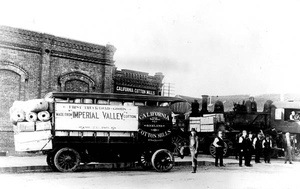 California Cotton Mills (Nov. 25, 1909)In 1884, the California Cotton Mills (City of Oakland Landmark #24) was built in North Kennedy. It was located there until the construction of the Nimitz Freeway, which literally cut right through the center of the mill. (The mill was in operation between 1883 and 1954). Mill owners incentivized inland farmers to grow cotton by offering free cottonseed in return for crop purchase at fair price. A resulting boom in cotton production, coupled with the influx of Azorean immigrants and an 1890 housing development on the North Kennedy Tract, enabled the mill to become the largest of its kind west of Chicago. During World War II, the mill made tents and parachutes used by the Army for the war effort. The mill later expanded into making automobile upholstery during Oakland’s auto manufacturing boom. Other industrial sites included a Del Monte cannery, a Montgomery Ward plant, L.A. Young Spring and Wire Works, and the winter headquarters of the Foley and Burk Carnival. The Cotton Mills are now home to artist studios.
California Cotton Mills (Nov. 25, 1909)In 1884, the California Cotton Mills (City of Oakland Landmark #24) was built in North Kennedy. It was located there until the construction of the Nimitz Freeway, which literally cut right through the center of the mill. (The mill was in operation between 1883 and 1954). Mill owners incentivized inland farmers to grow cotton by offering free cottonseed in return for crop purchase at fair price. A resulting boom in cotton production, coupled with the influx of Azorean immigrants and an 1890 housing development on the North Kennedy Tract, enabled the mill to become the largest of its kind west of Chicago. During World War II, the mill made tents and parachutes used by the Army for the war effort. The mill later expanded into making automobile upholstery during Oakland’s auto manufacturing boom. Other industrial sites included a Del Monte cannery, a Montgomery Ward plant, L.A. Young Spring and Wire Works, and the winter headquarters of the Foley and Burk Carnival. The Cotton Mills are now home to artist studios.
There was a Del Monte Cannery (now the location of the Fruitvale Station shopping center) and a large Montgomery Wards building.
Chicano and Latino Organizing
The North Kennedy Tract community was majority Portuguese and Azorean through the 1940s and 1950s. Community life revolved around the Mary Help of Christians Church, built in 1915, and the Lazear School, both of which acted as community centers. The church would organize a yearly Azorean Holy Ghost festival and parade (Festas do Espírito Santo). Bread made at the local bakery, Mendonças, was blessed and given as the "body of Christ" during the Holy Communion (Eucharist). As Chicanos and Latinos began moving into the neighborhood in the 1940s, the church began offering bilingual Spanish-English mass. An Influx of Chicanos and Latinos began moving to Jingletown during the late 1950s and 1960s due to the Urban Renewal and Destruction of the Old West Oakland Latino community. Beginning in the late 1960s, Jingletown became a center for the Chicano Movement. Organizations like the the Chicano Revolutionary Party offered free daily breakfasts to schoolchildren at the church. Another Organization worked with youth in the community was Frente Liberacion del Pueblo which worked with troubled Chicano and black youth in Jingletown. Malaquias Montoya a Chicano artist Started (Malaf) Mexican American liberation art front in Jingletown and This Organization played a big part in the Chicano Artist Movement in Oakland and the East Bay. The Chicano Moratorium protest against the Vietnam War was organized in Jingletown by Chicano radicals on July 26, 1970 Today Half of Jingletowns Population is still Chicano Mexican and Latino.
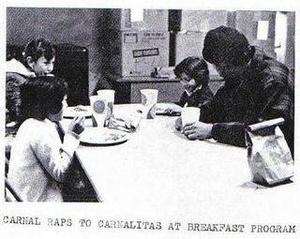 Chicano Revolutionary Party Free breakfast program in Jingletown
Chicano Revolutionary Party Free breakfast program in Jingletown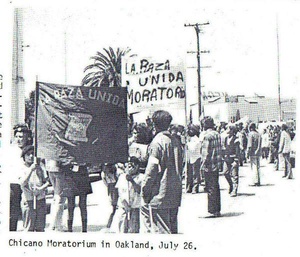 Chicano Moratorium July 26 1970. in front of Mary help of Christians Church.
Chicano Moratorium July 26 1970. in front of Mary help of Christians Church.
In 1974, Jingletown was rezoned from industrial to residential after fears that the community would be displaced by a proposed Del Monte cannery expansion. Chicano, black and Portuguese activists organized to stop the demolition of Jingletown. Jingletown also expirenced a rise in Crime during the 1980s and 1990s Especially after the Crack epidemic various Chicano Gangs like Jingletown (JT) and E7th st Locos and few Drug Dealers were based out of Jingletown there were several homicides in the area during this time. Funded by federal government housing subsidies in the late 1990s, old factory buildings were converted into artists' live-work spaces, and in 1999 the City of Oakland relocated its animal shelter to Jingletown. Jingletown residents, artists and business owners currently organize through a grassroots community collective called the Jingletown Arts and Business Community (visit JABC website). The JABC is located here.
Arts Community
Through redevelopment in the 1990s, Jingletown has become a small arts center.
Institute of Mosaic Art
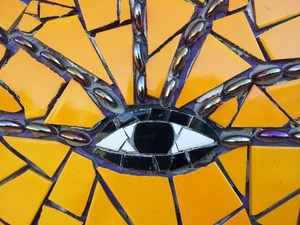 The mosaics are watching you...
The mosaics are watching you...
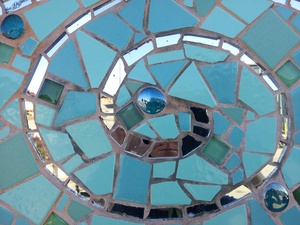 Details of the Institute of Mosaic Art exteriorThe Institute of Mosaic Art, founded in 2005, is the largest education center of its type in the United States. The institute was located at 3001 Chapman Street; in 2013 it moved to Berkeley. The building is now home to Jingletown Art Studios. The exterior of the building is painted bright purple, with multi-colored and mirrored mosaic tiles depicting fantastical buildings, flowers and hearts. Depictions of eyes are found as a recurring theme throughout the mosaics covering the building. Here are pictures of many more mosaics on and around the building.
Details of the Institute of Mosaic Art exteriorThe Institute of Mosaic Art, founded in 2005, is the largest education center of its type in the United States. The institute was located at 3001 Chapman Street; in 2013 it moved to Berkeley. The building is now home to Jingletown Art Studios. The exterior of the building is painted bright purple, with multi-colored and mirrored mosaic tiles depicting fantastical buildings, flowers and hearts. Depictions of eyes are found as a recurring theme throughout the mosaics covering the building. Here are pictures of many more mosaics on and around the building.
Chthonic Theater
Write something about this arts collective! :]
Places to visit
Rue de Merde
 The lizard of the Rue
The lizard of the Rue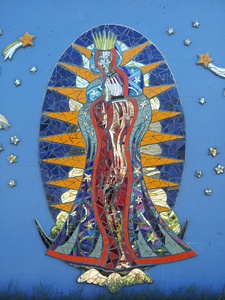 A mosaic depicting the VirginThe Rue de Merde, located on Peterson St. between Ford and Glascock, is a one-block open dog run bordered to the southeast by a compilation of mosaics and murals.
A mosaic depicting the VirginThe Rue de Merde, located on Peterson St. between Ford and Glascock, is a one-block open dog run bordered to the southeast by a compilation of mosaics and murals.
Pages tagged “jingletown”
Links and References
- Jingletown on Wikipedia



